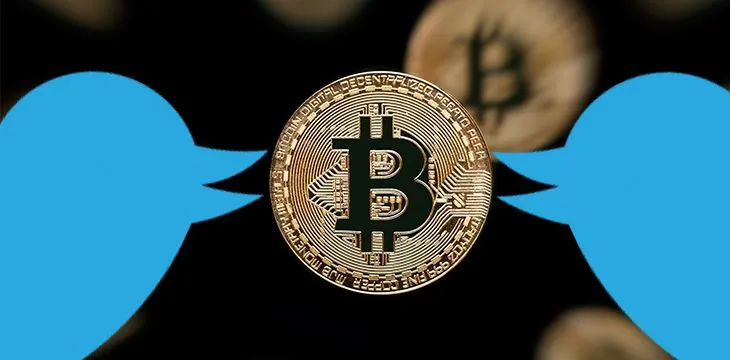|
Getting your Trinity Audio player ready...
|
The wider Bitcoin world celebrated Twitter’s February 2 proclamation that it would introduce a “Bitcoin emoji”. However the decision has also been controversial—mainly because it appears automatically when users type the hashtags #Bitcoin and #BTC, but not #BSV or even #BCH.
The Twitter Bitcoin emoji’s appearance also ruffled a few feathers. A capital “B” with two vertical lines through it has long been the unofficially-official Bitcoin logo. Prior to the two major hard forks in the Bitcoin network in August 2017 and November 2018, the “B” was generally orange, or white in an orange circle. In the circle logo form it also pointed down slightly.
Post-forks, claimants to the Bitcoin name have introduced subtle changes to the B to differentiate themselves. Bitcoin (BSV) has an upright “B” on a lighter, more yellow background. BCH tilted the “B” upward and its logo is more often green. BTC kept the original logo in orange, along with the “BTC” exchange ticker symbol (though some exchanges and services use “XBT”).
BTC Core’s claim to supremacy rests on its market cap and hashing power, along with the “BTC” abbreviation. The orange logo itself is more of a convention, and sometimes BSV and BCH users are happy to use it.
What has Twitter and Dorsey endorsed?
We should note that Twitter’s Bitcoin pictogram is not an “emoji” per se. It only works on Twitter, and only if you type the two specified hashtags. “Official” emojis are defined in the Unicode standard for computing, and can be selected from a list and transmitted across different platforms.
Currently, there is still no Unicode symbol for Bitcoin, despite years of lobbying by the Bitcoin community.
Twitter’s move is significant because it appears to be an official endorsement of BTC by Twitter, not only of the Bitcoin concept, but also of BTC’s legitimacy as the only Bitcoin. BTC, an exchange ticker symbol and common abbreviation, refers these days only to the Core project.
Bitcoin SV is the only Bitcoin that adheres to the original code and functionality laid out in Satoshi Nakamoto’s 2008 Bitcoin whitepaper. Since February 4, 2020, when the network activated Bitcoin v1.0.0 (codenamed “Genesis”), it has made fundamental changes to the base protocol virtually impossible.
BTC and BCH have altered the protocol in ways that changes both its functionality and economic incentives. BTC has limited the transaction block size to 1-4MB, and introduced “second layer” (i.e. separate to Bitcoin) protocols for most payments. BCH has implemented new code on the base protocol to make it impossible for separate chains to reconcile at a future point, and floated other protocol-level changes to make BCH more anonymous and harder to trace.
Bitcoin battle to turn legal
Investor Calvin Ayre, a major Bitcoin SV supporter, tweeted his disapproval at Twitter CEO Jack Dorsey:
Hi Jack. BTC is not Bitcoin and with the lawsuits that I know are coming related to this issue, this year. Your putting your finger on the scale on the wrong side of facts is not going to end well for Twitter.
— Calvin Ayre (@CalvinAyre) February 3, 2020
He also hinted the now-symbolic battle for Bitcoin’s identity could soon be a legal one, fought with patents and other intellectual property rights. Bitcoin SV software company nChain and chief scientist Dr. Craig Wright hold several patents related to common blockchain technologies.
Emojis have real power
Emojis are serious business. They first became popular in Japan in the late 1990s as an alternative to text communication, and these days form an alternative writing system that some speculate may come to replace written letters or words.
They can convey ideas, objects and emotions more efficiently than words, and can be understood by most people regardless of the language they speak. However this has also created controversies.
The power to control language and expression of thoughts is as significant as the power to control a population’s money supply. Emojis are standardized in Unicode so they can work cross-platform. Therefore, whether a certain emoji is included, removed or added, can cause major debates as they “legitimize” (or de-legitimize) concepts allowed in public discourse. For example, the realistic handgun emoji was replaced by a colorful toy zap gun; the list of official family and relationship emojis has expanded to reflect more socially-progressive ideals. The “bomb” emoji is constantly under threat, and new varieties of skin tone and hair color have been introduced.
In Nineteen Eighty-Four, George Orwell wrote of a totalitarian government’s efforts to control people’s thoughts via manipulation of the official language, called Newspeak. Emojis may or may not be an attempt to create a form of Newspeak, but the debates they cause highlight how important the official Unicode list is.
Symbolism for Bitcoin and others
Small, symbolic and seemingly insignificant events can matter a lot in the cryptocurrency world. Acknowledgement of its existence or legitimacy by a major banker or CEO; signs in a crowd; the slimmest possibility that a marquee user is studying it—all are part of the hearts-and-minds battle to win the general public’s attention and, maybe someday, acceptance.
But there are now thousands of blockchain and cryptocurrency projects, of which about 10-20 are vying seriously to become the new world currency. It’s been a decade-long struggle and yet the mere mention of a certain coin outside enthusiast circles could be a foot in the door to something greater.
As the original blockchain, Bitcoin has the main advantage. The problem is, three large groups claim theirs is the “only” or “real” Bitcoin, and the other two aren’t. Years of social media debates haven’t solved the matter, and Bitcoin SV’s IP holders have signaled intent to prove their claim in law. Though it might sound trivial, emojis could end up involved in all this too.
It’s unlikely, though not impossible, the Unicode list could compromise by introducing a wide selection of blockchain-related emojis. Or it may continue to exclude all of them until there’s only one left.
Twitter’s misguided choice of BTC-means-Bitcoin for its own emoji-like pictogram could even become a mainstream issue in 2020 and beyond. The company may have been wiser to stay out of the debate, intentionally or otherwise.

 09-15-2025
09-15-2025 





